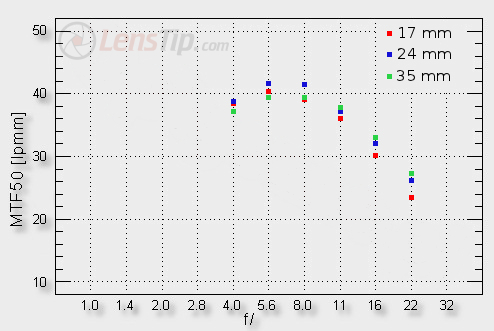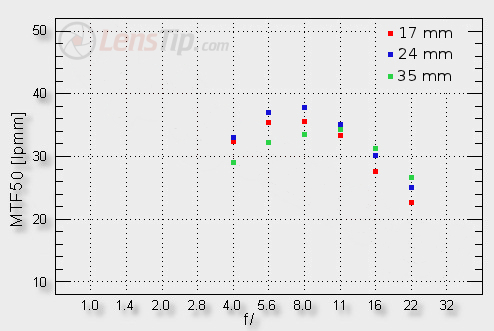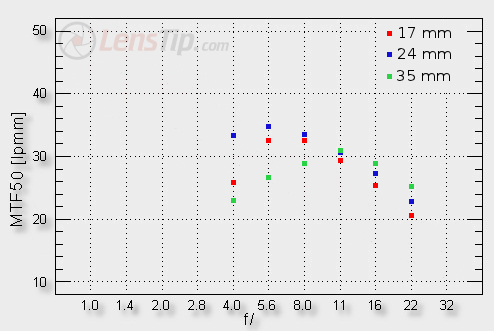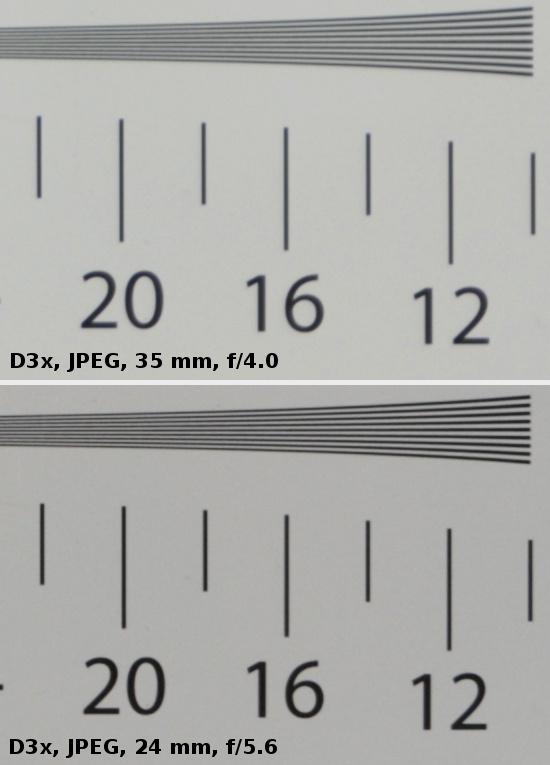Tokina AT-X PRO FX SD 17-35 mm f/4 (IF)
4. Image resolution
First, let’s check how the lens performs in the frame centre. The graph below presents MTF50 function values, reached at 17,24 and 35 mm by particular apertures.

Please Support UsIf you enjoy our reviews and articles, and you want us to continue our work please, support our website by donating through PayPal. The funds are going to be used for paying our editorial team, renting servers, and equipping our testing studio; only that way we will be able to continue providing you interesting content for free. |
- - - - - - - - - - - - - - - - - - - - - - - - - - - - - - - - - - - - - - - - - - - - - - - -
The results of the resolution analysis in the frame centre create a very pleasant picture. The lens’s performance is very even, without any significant differences between different focal lengths. At the maximum relative aperture, no matter what focal length you employ, the images are of good quality – the MTF50 values amount to about 38 lpmm. By f/5.6 and f/8.0 the lens reaches the peak of its possibilities, with the MTFs on a level of 39-42 lpmm so providing very sharp photos. Still you definitely can’t speak about excellent or outstanding results.
Let’s check now the situation on the edge of the APS-C/DX sensor.

Here you don’t get such even values. The best performance can be observed in the middle of the focal range, the worst – at the maximum focal length. Still you can hardly complain. Only at the combination of the maximum aperture and 35 mm focal length the results are on the decency borderline; all other focal lengths in the range of apertures from f/4.0 to f/11 provide images which can be considered fully useful or even good.
The next graph presents the performance of the Tokina 17-35 mm on the edge of the full frame sensor.

Here the differences between particular focal lengths are even greater. We have no reservations concerning the performance in the centre of the range, where, even at the maximum relative aperture, the image remains fully useful, improving to good on the stopping down. The results at 35 mm are the opposite of that because even applying f/8.0 aperture is not enough to get useful images. The 17 mm focal length is lacking only at the maximum relative aperture; after stopping down the MTFs rise to a level which we deem to be more or less acceptable.
To sum up you can say that the Tokina 17-35 mm fared well in the resolution test. We had no reservations concerning the frame centre and the edge of the APS-C/DX sensor. On full frame the 35 mm focal length is the weakest; however, if it is supposed to be a compromise you have to agree to in order to make the performance of the lens at other focal lengths better, we are prepared to accept it.
At the end of the chapter we present some crops taken from our resolution testing chart photos; they were saved as JPEG files along with RAW files, used for the analysis above.
 |






